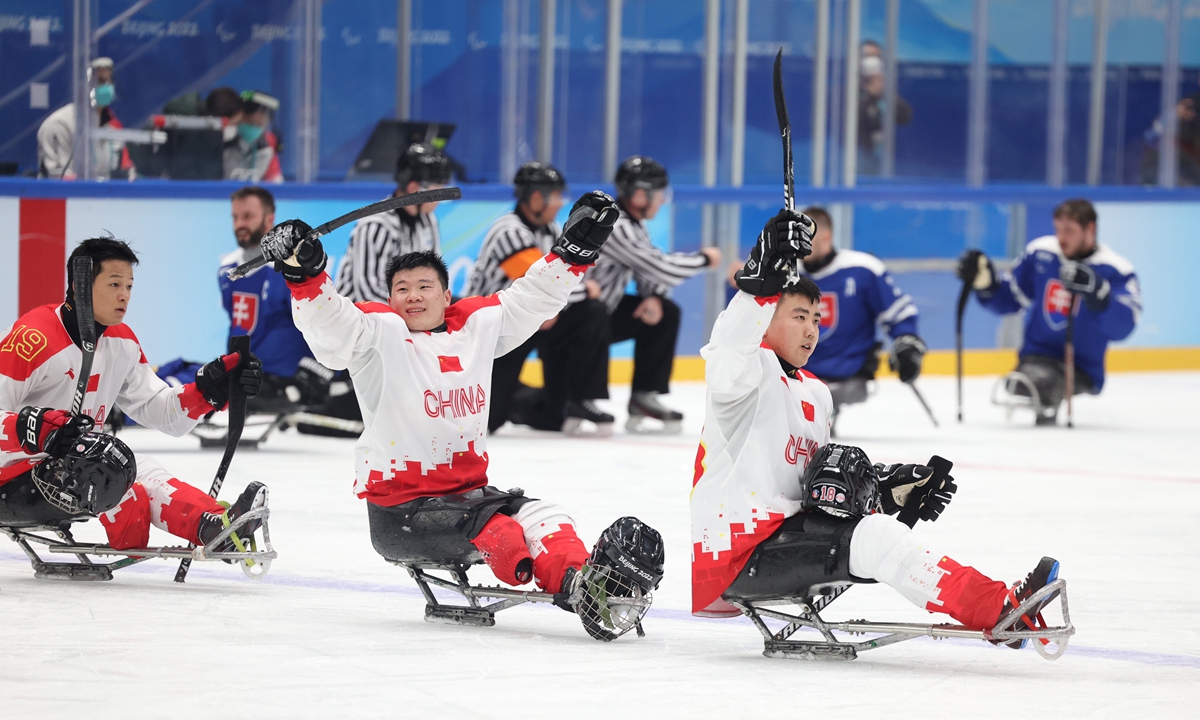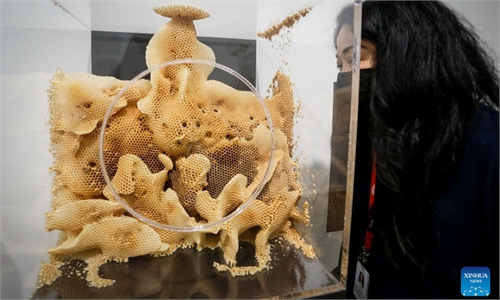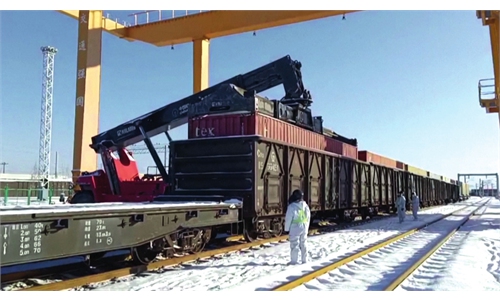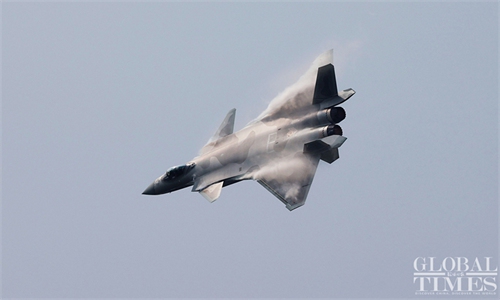Cutting-edge tech empowers Paralympics to bring participants state-of-the-art experiences
AI, VR bring athletes, spectators state-of-the-art experiences

Team China celebrates a 7-0 Para ice hockey victory over Slovakia in the opening match on March 5. Photo: cnsphoto
Despite the Beijing 2022 Paralympic Winter Games drawing to a close on Sunday, the sports event's legacy inheritance has just begun, being carried from the competition venue to streets, with various technologies applied at the event that have touched athletes from all over the world expected to be made available to the disabled people.
From service robots to the combination of and sports events, the Winter Paralympics has used cutting-edge technologies to provide inclusive communication and hospitality, and utilized state-of-the-art services for athletes and spectators.
Analysts pointed out the widely adopted technologies during the Beijing 2022 Winter Olympics and Paralympics reflected the breakthroughs and progress that China has achieved in multiple key sectors such as robots, artificial intelligence (AI) and augmented reality (AR).
Lü Shiming, vice president of the China Disabled Persons' Federation, said that "many technologies put on display at the Winter Paralympics have fully demonstrated China's high-level innovation and high-quality development in the field of barrier-free technology and intelligence."
While technology has empowered the Winter Paralympics, it will also leave a rich Olympic legacy and bring new hope to the majority of groups that need that technology to better their life, according to Lü.
360-degree broadcast
Global audiences could enjoy the Paralympic Winter Games as if they watch competitions in person thanks to the advanced 5G free-viewpoint virtual reality (VR) video system developed by a Chinese research team led by Peking University (PKU).
During the Para ice hockey tournament, in which Team China made a stunning start in the opening match with a 7-0 rout of Slovakia, people who watched the competition via broadcast experienced free-viewpoint access to replays of the game's highlights.
The immersive viewing experience was made possible by a free-viewpoint video system incorporating intelligent algorithms set in the venue, cooperating with 60 broadcast-grade ultra high-definition cameras and several servers and network devices.
The interactive VR technology can reach ordinary audiences directly with 5G mobile phones and networks, as users can watch games through the free-viewpoint video system without special equipment or dedicated bandwidth.
"The events showcased China's progressive development and breakthroughs in both soft and hard power such as the large-scale use of algorithms and the optimization of the use of VR," Liu Gang, director of the Nankai Institute of Economics and chief economist at the Chinese Institute of New Generation AI Development Strategies, told the Global Times.
Barrier-free accessibility
Robots have become a friendly helper and companion during both the Beijing Winter Olympics and the Paralympics as they were widely applied in assisting competitive events and athletes themselves, reflecting China's emphasis on the events and safety of athletes from all over the world.
Given the particularity of the Paralympics, exoskeleton robots empowered by AI technologies help to judge users' movement intention in real time, provide movement assistance that matches its own ability according to the ground features and changes in the surroundings, meanwhile help users activate muscle strength and control gait.
On March 2, Shao Haipeng, one of the nine representatives who lit the torch at the ceremony of gathering nine flames and the torch relay for the Paralympics, walked onto the platform wearing an exoskeleton robot, attracting widespread interest.
Developed by the exoskeleton laboratory of Beijing Advanced Innovation Center for Biomedical Engineering and researcher of the School of Biological Science and Medical Engineering, Beihang University, the robots can help the torchbearers realize their dream of standing and walking and carrying the torch.
"AI exoskeleton robots can sense how fast or slow a person walks, and realize the self-adaptation of robotic assistance and human behavior, including complex movements such as going up and down stairs or slopes," said Shuai Mei, director of the laboratory.
Expected to play an exemplary role in promoting the development of China's rehabilitation robot industry, the AI exoskeleton robots have become a new means of treating paralysis, achieving technological innovation and benefiting the general public. The technology will be made available to the market in the future, benefiting ordinary people with disabilities, according to Shuai.
Liu Dingding, a veteran industry analyst, told the Global Times on Sunday that the use of robots previously was more about concepts and theories, whereas the Beijing Winter Olympics and Paralympics focused on the practical use of different robots targeting different purposes.
Moreover, robots designed specifically for the epidemic prevention purposes such as conducting contactless services and measuring temperature have been implemented in various scenarios and occasions across the country even before the sports gala.
"China has already come up with tons of successful cases in robots, smart manufacturing, and intelligent applications which can be adopted for future practices and large-scale demonstration," he added.
Moving forward, robots will be designed the public's current demand and needs in mind while assisting in work and production, according to Liu.
Jia Hongguang, a Chinese gold medalist at the Tokyo Paralympics, gripped the Paralympics torch with a bionic hand and handed it to the next torchbearer to complete his leg of the torch relay on March 2, which let him own the amazing feeling of having hands thanks to scientific and technological innovation.
The intelligent bionic hand worn on Jia's right arm can realize motion control by collecting and processing the electromyographic nerve signals generated by human muscle movement, and holds the torch flexibly and naturally.
People who shook hands with Jia said that although the bionic hand has no temperature, the strength of the handshake is moderate, neither tight nor loose, according to media reports.
The state-of-the-art product was developed by BrainCo, a brain-machine interface start-up that is dedicated to developing Brain Machine Interface technology, and it is the first Chinese team selected by the Harvard Innovation Lab.
At present, hundreds of people across the country have tried the product, which can be used for typing, playing the piano, operating machinery, doing housework and farm work, a representative of the start-up said.
"The construction of a barrier-free environment has received widespread attention from around the world and has become a highlight of the competition, representing Chinese wisdom, achievements and image. In the two sessions over recent years, 'barrier-free' has attracted the high attention of the delegates," said Lü from the China Disabled Persons' Federation, who called for the inclusion of barrier-free environment construction into the public credit system during this year's two sessions.



